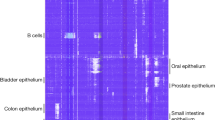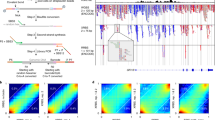Abstract
Current DNA methylation assays are limited in the flexibility and efficiency of characterizing a large number of genomic targets. We report a method to specifically capture an arbitrary subset of genomic targets for single-molecule bisulfite sequencing for digital quantification of DNA methylation at single-nucleotide resolution. A set of ~30,000 padlock probes was designed to assess methylation of ~66,000 CpG sites within 2,020 CpG islands on human chromosome 12, chromosome 20, and 34 selected regions. To investigate epigenetic differences associated with dedifferentiation, we compared methylation in three human fibroblast lines and eight human pluripotent stem cell lines. Chromosome-wide methylation patterns were similar among all lines studied, but cytosine methylation was slightly more prevalent in the pluripotent cells than in the fibroblasts. Induced pluripotent stem (iPS) cells appeared to display more methylation than embryonic stem cells. We found 288 regions methylated differently in fibroblasts and pluripotent cells. This targeted approach should be particularly useful for analyzing DNA methylation in large genomes.
This is a preview of subscription content, access via your institution
Access options
Subscribe to this journal
Receive 12 print issues and online access
$209.00 per year
only $17.42 per issue
Buy this article
- Purchase on Springer Link
- Instant access to full article PDF
Prices may be subject to local taxes which are calculated during checkout



Similar content being viewed by others
Accession codes
References
Zilberman, D. & Henikoff, S. Genome-wide analysis of DNA methylation patterns. Development 134, 3959–3965 (2007).
Bibikova, M. et al. High-throughput DNA methylation profiling using universal bead arrays. Genome Res. 16, 383–393 (2006).
Bibikova, M. et al. Human embryonic stem cells have a unique epigenetic signature. Genome Res. 16, 1075–1083 (2006).
Irizarry, R.A. et al. Comprehensive high-throughput arrays for relative methylation (CHARM). Genome Res. 18, 780–790 (2008).
Zhang, X. et al. Genome-wide high-resolution mapping and functional analysis of DNA methylation in arabidopsis. Cell 126, 1189–1201 (2006).
Khulan, B. et al. Comparative isoschizomer profiling of cytosine methylation: the HELP assay. Genome Res. 16, 1046–1055 (2006).
Eckhardt, F. et al. DNA methylation profiling of human chromosomes 6, 20 and 22. Nat. Genet. 38, 1378–1385 (2006).
Rakyan, V.K. et al. DNA methylation profiling of the human major histocompatibility complex: a pilot study for the human epigenome project. PLoS Biol. 2, e405 (2004).
Taylor, K.H. et al. Ultradeep bisulfite sequencing analysis of DNA methylation patterns in multiple gene promoters by 454 sequencing. Cancer Res. 67, 8511–8518 (2007).
Meissner, A. et al. Reduced representation bisulfite sequencing for comparative high-resolution DNA methylation analysis. Nucleic Acids Res. 33, 5868–5877 (2005).
Meissner, A. et al. Genome-scale DNA methylation maps of pluripotent and differentiated cells. Nature 454, 766–770 (2008).
Cokus, S.J. et al. Shotgun bisulphite sequencing of the Arabidopsis genome reveals DNA methylation patterning. Nature 452, 215–219 (2008).
Lister, R. et al. Highly integrated single-base resolution maps of the epigenome in Arabidopsis. Cell 133, 523–536 (2008).
Suzuki, M.M. & Bird, A. DNA methylation landscapes: provocative insights from epigenomics. Nat. Rev. Genet. 9, 465–476 (2008).
Porreca, G.J. et al. Multiplex amplification of large sets of human exons. Nat. Methods 4, 931–936 (2007).
Quail, M.A. et al. A large genome center's improvements to the Illumina sequencing system. Nat. Methods 5, 1005–1010 (2008).
Yu, J. et al. Induced pluripotent stem cell lines derived from human somatic cells. Science 318, 1917–1920 (2007).
Park, I.H. et al. Reprogramming of human somatic cells to pluripotency with defined factors. Nature 451, 141–146 (2008).
Maherali, N. et al. A high-efficiency system for the generation and study of human induced pluripotent stem cells. Cell Stem Cell 3, 340–345 (2008).
Cowan, C.A., Atienza, J., Melton, D.A. & Eggan, K. Nuclear reprogramming of somatic cells after fusion with human embryonic stem cells. Science 309, 1369–1373 (2005).
Jones, P.A. The DNA methylation paradox. Trends Genet. 15, 34–37 (1999).
Hellman, A. & Chess, A. Gene body-specific methylation on the active X chromosome. Science 315, 1141–1143 (2007).
Ball, M.P. et al. Targeted and genome-scale strategies reveal gene-body methylation signatures in human cells. Nat. Biotechnol. advance online publication, doi:10.1038/nbt.1533 (29 March 2009).
Dennis, G. Jr. et al. DAVID: database for annotation, visualization, and integrated discovery. Genome Biol. 4, 3 (2003).
Müller, F.J. et al. Regulatory networks define phenotypic classes of human stem cell lines. Nature 455, 401–405 (2008).
Hardenbol, P. et al. Multiplexed genotyping with sequence-tagged molecular inversion probes. Nat. Biotechnol. 21, 673–678 (2003).
Irizarry, R.A. et al. The human colon cancer methylome shows similar hypo- and hypermethylation at conserved tissue-specific CpG island shores. Nat. Genet. 41, 178–186 (2009).
Gnirke, A. et al. Solution hybrid selection with ultra-long oligonucleotides for massively parallel targeted sequencing. Nat. Biotechnol. 27, 182–189 (2009).
Gardiner-Garden, M. & Frommer, M. CpG islands in vertebrate genomes. J. Mol. Biol. 196, 261–282 (1987).
Mikkelsen, T.S. et al. Dissecting direct reprogramming through integrative genomic analysis. Nature 454, 49–55 (2008).
Li, R., Li, Y., Kristiansen, K. & Wang, J. SOAP: short oligonucleotide alignment program. Bioinformatics 24, 713–714 (2008).
Acknowledgements
We thank George Church, Billy Jin Li, Jay Shendure for inputs related to padlock probes; Huidong Shi, Billy Jin Li and Madeleine Ball for suggestions on methylation analysis; Ruiqiang Li for suggestions on read mapping; James Sprague for assistance on gene expression profiling, Colleen Ludka for assistance on Illumina sequencing. This work was supported by the UCSD new faculty startup fund, and partially by NIH/NIDA R01-DA025779 (to K.Z.). J.D. was sponsored by a CIRM post-doctoral fellowship.
Author information
Authors and Affiliations
Contributions
K.Z. and Y.G. oversaw the project. J.D. and K.Z. designed and performed experiments related to padlock probe preparation, target capture, sequencing library construction and various validation assays. B.X. and Y.G. performed Illumina sequencing. E.M.L. provided oligonucleotide libraries. J.A.-B., D.E., N.M., I.-H.P., J.Y. G.Q.D., K.E. K.H. J.T. provided DNA/RNA from stem cells and fibroblasts. J.D., R.S., A.G. W.W., Y.G., and K.Z. performed data analysis. J.D. and K.Z wrote the manuscript.
Corresponding authors
Ethics declarations
Competing interests
K.Z. is a co-inventor in a patent application related to the method described in this publication. E.L. is an employee of Agilent Technology, which manufactures and sells oligonucleotide libraries.
Supplementary information
Supplementary Text and Figures
Supplementary Figures 1–8, Supplementary Tables 1–6,8. (PDF 993 kb)
Supplementary Table 7
Sequences and annotations of all padlock probes. (XLS 12767 kb)
Supplementary Data
Perl scripts and related data files for probe design and data analysis. (ZIP 19536 kb)
Rights and permissions
About this article
Cite this article
Deng, J., Shoemaker, R., Xie, B. et al. Targeted bisulfite sequencing reveals changes in DNA methylation associated with nuclear reprogramming. Nat Biotechnol 27, 353–360 (2009). https://doi.org/10.1038/nbt.1530
Received:
Accepted:
Published:
Issue Date:
DOI: https://doi.org/10.1038/nbt.1530
This article is cited by
-
Introduction of a multiplex amplicon sequencing assay to quantify DNA methylation in target cytosine markers underlying four selected epigenetic clocks
Clinical Epigenetics (2023)
-
Methylated SEPT9 combined with AFP and PIVKA-II is effective for the detection of HCC in high-risk population
BMC Gastroenterology (2023)
-
Maternal obesity alters methylation level of cytosine in CpG island for epigenetic inheritance in fetal umbilical cord blood
Human Genomics (2022)
-
Limitations and opportunities of technologies for the analysis of cell-free DNA in cancer diagnostics
Nature Biomedical Engineering (2022)
-
Epigenetic deregulation of lamina-associated domains in Hutchinson-Gilford progeria syndrome
Genome Medicine (2020)



